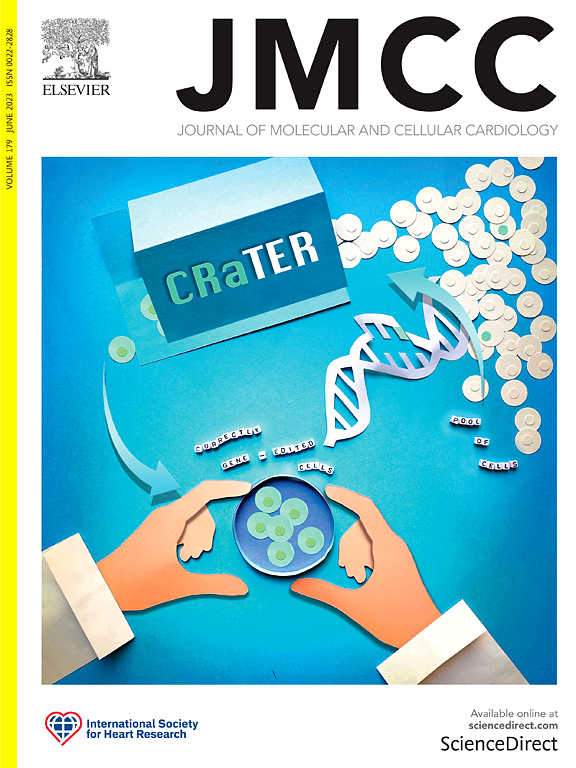Ca2+ sensitivity changes in skinned myocardial fibers induced by myosin–actin crossbridge-independent sarcomere stretch: Role of N-domain of MyBP-C
IF 4.7
2区 医学
Q1 CARDIAC & CARDIOVASCULAR SYSTEMS
引用次数: 0
Abstract
Sarcomere length-dependent activation (LDA) is the key cellular mechanism underlying the Frank-Starling law of the heart, in which sarcomere stretch leads to increased Ca2+ sensitivity of myofilament and force of contraction. Despite its key role in both normal and pathological states, the precise mechanisms underlying LDA remain unclear but are thought to involve multiple interactions among sarcomere proteins, including troponin of the thin filament, myosin, titin and myosin binding protein C (MyBP-C). Our previous study with permeabilized rat cardiac fibers demonstrated that the mechanism underlying the increase in Ca2+ sensitivity of thin filament induced by sarcomere stretch may involve sarcomere length (SL)-induced interactions between troponin and weakly bound, disordered relaxed state (DRX) myosin heads in diastole, rather than strong myosin–actin crossbridge interactions. In this study we investigated the role of the N-domains of MyBP-C in this newly discovered mechanism. To examine the potential role of the N-domain of MyBP-C in SL-induced myosin-troponin interactions, skinned myocardial fibers from a transgenic ΔN-MyBP-C rat with deleted N-terminal C0-C2 domains and a non-transgenic rat were reconstituted with troponin containing wild-type cTnT, cTnC(13C/51C)AEDANS-DDPM and mutant ΔSP-cTnI or wild-type cTnI. Because the switching peptide (SP) of ΔS-cTnI is replaced by a nonfunctional peptide linker, force-generating actin-myosin crossbridge interactions of the reconstituted skinned fibers with mutant ΔSP-cTnI are inhibited regardless of the presence of Ca2+. This approach allowed us to examine the sensitivity of troponin/thin filament to Ca2+ binding in response to sarcomere stretch by monitoring Ca2+-induced changes in fluorescence resonance energy transfer (FRET) between AEDANS and DDPM attached to the N-domain of cTnC in the presence/absence of myosin–actin crossbridge interaction with or without deletion of C0-C2 domains of MyBP-C. Our measurements of SL-induced changes in muscle fiber mechanics and FRET Ca2+ sensitivities provide strong evidence that both the weakly bound myosin heads and the N-terminus of MyBP-C are critical for SL to activate troponin in the diastolic state. A model based on the results is proposed for the mechanism underlying LDA of myofilament.

肌球蛋白-肌动蛋白桥非依赖性肌节拉伸诱导皮肤心肌纤维Ca2+敏感性变化:MyBP-C n结构域的作用
肌节长度依赖性激活(LDA)是心脏Frank-Starling定律的关键细胞机制,其中肌节拉伸导致肌丝Ca2+敏感性和收缩力增加。尽管它在正常和病理状态中都起着关键作用,但LDA的确切机制尚不清楚,但被认为涉及肌瘤蛋白之间的多种相互作用,包括细丝肌钙蛋白、肌凝蛋白、肌凝蛋白和肌凝蛋白结合蛋白C (MyBP-C)。我们之前对渗透大鼠心脏纤维的研究表明,肌节拉伸诱导的细纤维Ca2+敏感性增加的机制可能涉及肌节长度(SL)诱导的肌钙蛋白与舒张期弱结合、无序松弛状态(DRX)肌球蛋白头之间的相互作用,而不是强肌球蛋白-肌动蛋白交叉桥相互作用。在这项研究中,我们研究了MyBP-C的n结构域在这一新发现的机制中的作用。为了研究MyBP-C的n结构域在sl诱导的肌球蛋白-肌钙蛋白相互作用中的潜在作用,我们用含有野生型cTnT、cTnC(13C/51C)AEDANS-DDPM和突变体ΔSP-cTnI或野生型cTnI的肌钙蛋白重组了n端C0-C2结构域缺失的转基因ΔN-MyBP-C大鼠和非转基因大鼠的去皮心肌纤维。因为ΔS-cTnI的开关肽(SP)被一个无功能的肽连接物所取代,无论Ca2+的存在与否,重建的表皮纤维与突变体ΔSP-cTnI之间产生力的肌动蛋白-肌球蛋白交叉桥相互作用都被抑制。这种方法允许我们检测肌钙蛋白/细丝对Ca2+结合的敏感性,以响应肌节拉伸,通过监测Ca2+诱导的荧光共振能量转移(FRET)在AEDANS和DDPM之间的变化,连接到cTnC的n结构域,存在/不存在肌球蛋白-肌动蛋白交叉桥相互作用,或不删除MyBP-C的C0-C2结构域。我们对SL诱导的肌纤维力学变化和FRET Ca2+敏感性的测量提供了强有力的证据,证明弱结合的肌球蛋白头部和MyBP-C的n端对于SL在舒张状态下激活肌钙蛋白至关重要。在此基础上提出了肌丝LDA机制的模型。
本文章由计算机程序翻译,如有差异,请以英文原文为准。
求助全文
约1分钟内获得全文
求助全文
来源期刊
CiteScore
10.70
自引率
0.00%
发文量
171
审稿时长
42 days
期刊介绍:
The Journal of Molecular and Cellular Cardiology publishes work advancing knowledge of the mechanisms responsible for both normal and diseased cardiovascular function. To this end papers are published in all relevant areas. These include (but are not limited to): structural biology; genetics; proteomics; morphology; stem cells; molecular biology; metabolism; biophysics; bioengineering; computational modeling and systems analysis; electrophysiology; pharmacology and physiology. Papers are encouraged with both basic and translational approaches. The journal is directed not only to basic scientists but also to clinical cardiologists who wish to follow the rapidly advancing frontiers of basic knowledge of the heart and circulation.

 求助内容:
求助内容: 应助结果提醒方式:
应助结果提醒方式:


